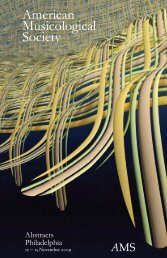Abstracts - American Musicological Society
Abstracts - American Musicological Society
Abstracts - American Musicological Society
You also want an ePaper? Increase the reach of your titles
YUMPU automatically turns print PDFs into web optimized ePapers that Google loves.
38 Thursday Afternoon: Session 1- 34<br />
AMS/SEM/SMT New Orleans 2012<br />
well-known old type, but also experiments what I have called the “new manner” inganni, the ones where chromatic alteration<br />
of the syllables is breaking the ordinary hexachord, therefore introducing potential structural modifications. I will show that<br />
there is a strong connection between the strategies chosen by the composers to alter their subjects and the form of the ricercar.<br />
Finally, this paper will demonstrate the importance of solmization theories as an analytical tool for this kind of repertoire.<br />
Maximally Self-Similar Melodies and Canons with Infinite Solutions<br />
Clifton Callender (Florida State University)<br />
Most canons, ranging from the very simple to the most complex, have a single solution. For example, Ciconia’s tempo<br />
canon Le ray au soleyl will only work at the ratios 4:3:1, and the canon by augmentation and inversion from Bach’s Musical<br />
Offering will not work in any other manner. However, some canons have multiple solutions, including a canon by inversion<br />
from the Musical Offering that has two distinct solutions and the multiple combinations of an eight-note theme in Bach’s<br />
Fourteen Canons on the Goldberg Ground. Are there limits to the number of solutions for canons that maintain some kind of<br />
strict harmonic control? Surprisingly, the answer is no! It is possible to create lines that can combine in an infinite number<br />
of ways while maintaining maximal harmonic consistency. Specifically, melodies that are maximally self-similar, exhibiting<br />
self-similarity at all possible time scales, can be combined in any number of voices, at any ratios (rational or irrational), with<br />
each voice moving either forward or backward. This presentation will explain the construction and provide examples of these<br />
canons with infinite solutions.<br />
Session 1-34 (AMS), 2:00–5:00<br />
Chopin Revisited<br />
Jeffrey Kallberg (University of Pennsylvania), Chair<br />
Nationalizing the Kujawiak and Constructions of Nostalgia in Chopin’s Mazurkas<br />
Halina Goldberg (Indiana University)<br />
In the musicological literature (including Grove), Chopin’s slow minor-key mazurkas and mazurka sections are typically labeled<br />
as kujawiak, a Polish folk dance from the Kujawy region. Yet Chopin’s lone use of this term, in his Fantasy on Polish Airs<br />
op. 13, marks a spirited (Vivace) dance in A major, contradicting the widely accepted definition. Similarly, kujawiaks found in<br />
the earliest publications, most notably in Oskar Kolberg’s 1860 collection of stylized dances, do not display the characteristics<br />
ascribed to them (slow tempo, minor mode) by later writers. The kujawiak is also absent from descriptions of Polish national<br />
dances by Chopin’s contemporaries. It is clear that at the time kujawiak was not a significant marker of Polishness in dance<br />
and that the term carried a different meaning from the one encountered in modern studies.<br />
Only in the last third of the nineteenth century did scholars attempt to link Chopin’s pieces to the folk kujawiak, a trend coinciding<br />
with the awakening of interest in the culture of Kujawy, which resulted in the publication of descriptions of the music<br />
and choreography of regional dances in the Orgelbrand Encyclopedia (vol. 16, 1864) and Kolberg’s Lud (series 4, 1867). The new<br />
inclusion of the kujawiak in the pantheon of Polish national dances provided a convenient musical and cultural link between<br />
the composer and the province he visited twice during his summer vacations. Moreover, the French roots of his father troubled<br />
proponents of an all-Polish Chopin, compelling them to seek confirmation of Chopin’s Polish pedigree in his mother’s origins<br />
in Kujawy. The purported musical connections between Chopin and his ancestral land reinforced this narrative.<br />
Chopin used the slow mazurka—the kind widely but anachronistically called kujawiak—to summon nostalgia for the<br />
spatially and temporally distant—and mythical—Poland. But rather than referencing his homeland through the supposed<br />
identity of this dance, Chopin invokes it through musical styles and gestures typical of then-popular characteristic pieces typically<br />
marked by the adjectives pathétique, elegique, lugubre, triste, or mélancolique.<br />
Ferruccio Busoni and the “Halfness” of Fryderyk Chopin:<br />
A Study about Gender Perception and Performance Interpretation<br />
Erinn Knyt (University of Massachusetts)<br />
Ferruccio Busoni’s performances of Fryderyk Chopin’s compositions elicited responses of quizzical amusement in the late<br />
nineteenth and early twentieth centuries. Even some of Busoni’s staunchest admirers had trouble appreciating his insertion of<br />
additional measures, the repetition of structural wholes in the preludes, registral or textural alterations, and his unsentimental<br />
interpretive style. Also unusual was his choice to program the preludes as a complete cycle.<br />
What was the rationale behind Busoni’s interpretive approach? My analysis of a previously unpublished and un-translated<br />
essay by Busoni, “Chopin: eine Ansicht über ihn,” in conjunction with analyses of recordings, concert programs, and recital<br />
reviews, connects Busoni’s unconventional Chopin interpretations to an idiosyncratic perception of Chopin’s character. As










